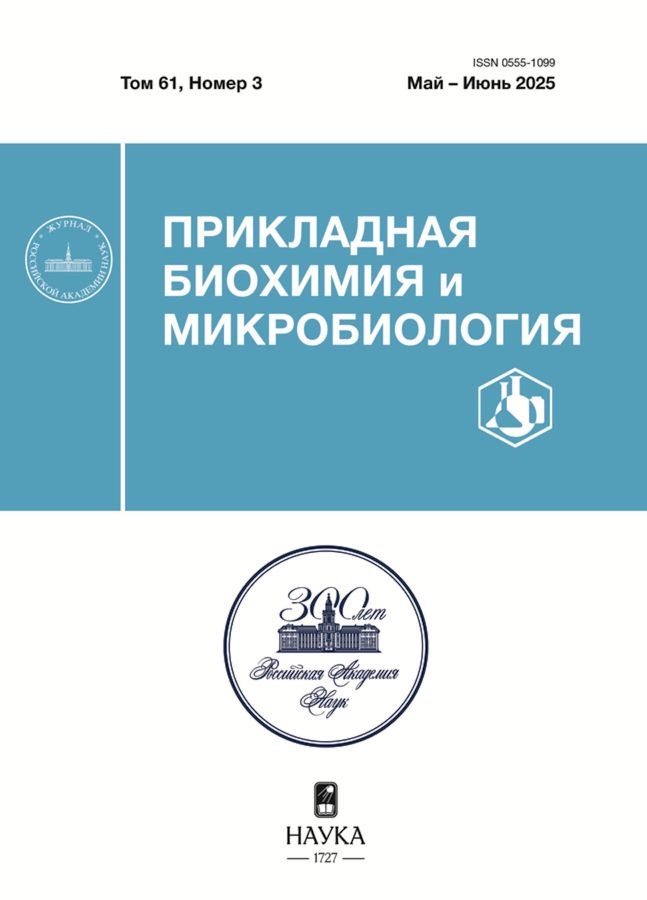Effect of fermentation by lactobacilli on the functional — technological properties of pea protein isolates
- Autores: Kravchenko I.V.1, Furalyov V.A.1, Pshennikova E.S.1, Fedorov A.N.1, Popov V.O.1
-
Afiliações:
- Bach Institute of Biochemistry, Federal Research Centre “Fundamentals of Biotechnology” of the Russian Academy of Sciences
- Edição: Volume 61, Nº 3 (2025)
- Páginas: 312-322
- Seção: Articles
- URL: https://cardiosomatics.ru/0555-1099/article/view/689357
- DOI: https://doi.org/10.31857/S0555109925030091
- EDN: https://elibrary.ru/DRXBNJ
- ID: 689357
Citar
Texto integral
Resumo
The effect of fermentation with three bacterial preparations: BK-Uglich-K, BK-Uglich-AB and BK-Uglich-P (Russia) on solubility, emulsifying activity, emulsion stability, foaming and foam stability of isolates preparated from two varieties of peas was studied. It has been shown that fermentation with bacterial cultures can increase the solubility of isolates at pH 3 by 4 to 17.5 times, at pH 4 — more than 3 times, at pH 5 — by 23% to 80%, at pH 6 — by 27% to 43%, at pH 7 — by 18% to 27%. Fermentation increased the index of emulsifying activity of isolates at pH 5 by 37% (in one of the varieties), the stability index of the emulsion at pH 3 by 19% to 28%, at pH 4 — by 17%, at pH 5 — by 18% (in one of the varieties), at pH 6 — by 16% to 35%. Fermentation increased the foaming of isolates at pH 3 by 2.2 times, at pH 4 by 1.4 to 2.4 times, at pH 5 and 6 by 1.8 to 4 times, at pH 7 by 2.1 to 2.4 times; at the same time, the stability of the foam of isolates at pH 4 increased by 11% to 22%, at pH 5 — by 11% to 13%, at pH 6 — by 15% (in one of the varieties), at pH 7 — 28% (in one of the varieties). The results obtained made it possible to select bacterial preparations to improve the parameters of pea protein isolates intended for the manufacture of various food products: pea cola (BK-Uglich-P), analogues of fermented milk products and analogues of milk (BK-Uglich-AB).
Palavras-chave
Texto integral
Sobre autores
I. Kravchenko
Bach Institute of Biochemistry, Federal Research Centre “Fundamentals of Biotechnology” of the Russian Academy of Sciences
Autor responsável pela correspondência
Email: ink71@yandex.ru
Rússia, Moscow, 119071
V. Furalyov
Bach Institute of Biochemistry, Federal Research Centre “Fundamentals of Biotechnology” of the Russian Academy of Sciences
Email: ink71@yandex.ru
Rússia, Moscow, 119071
E. Pshennikova
Bach Institute of Biochemistry, Federal Research Centre “Fundamentals of Biotechnology” of the Russian Academy of Sciences
Email: ink71@yandex.ru
Rússia, Moscow, 119071
A. Fedorov
Bach Institute of Biochemistry, Federal Research Centre “Fundamentals of Biotechnology” of the Russian Academy of Sciences
Email: ink71@yandex.ru
Rússia, Moscow, 119071
V. Popov
Bach Institute of Biochemistry, Federal Research Centre “Fundamentals of Biotechnology” of the Russian Academy of Sciences
Email: ink71@yandex.ru
Rússia, Moscow, 119071
Bibliografia
- Meinlschmidt P., Ueberham E., Lehmann J., Schweiggert-Weisz U., Eisner P. // Food Chem. 2016. V. 205. P. 229–238. https://doi.org/10.1016/j.foodchem.2016.03.016
- Schlegel K., Leidigkeit A., Eisner P., Schweiggert-Weisz U. // Foods. 2019. V. 8. Р. 678. https://doi.org/10.3390/foods8120678
- Lampart-Szczapa E., Konieczny P., Nogala-Kałucka M., Walczak S., Kossowska I., Malinowska M. // Food Chem. 2006. V. 96. P. 290–296. https://doi.org/10.1016/j.foodchem.2005.02.0315
- Liu Y., Zhu S., Li Y., Sun F., Huang D., Chen X. // Food Res. Int. 2023. V. 165. Р. 112453. https://doi.org/10.1016/j.foodres.2022.112453
- Schlegel K., Lidzba N., Ueberham E., Eisner P., Schweiggert-Weisz U. //Foods. 2021. V. 10. № 2. Р. 281. https://doi.org/10.3390/foods10020281
- Biscola V., de Olmos A. R., Choiset Y., Rabesona H., Garro M. S., Mozzi F., et al. // Beneficial Microbes. 2017. V. 8. № 4. P. 635–643. https://doi.org/10.3920/BM2016.0171
- El Mecherfi K.-E., Lupi R., Cherkaoui M., Albuquerque M. A., Todorov S. D., Tranquet O. et al. // Probiotics and Antimicrobial Proteins. 2022. V. 14. № 5. P. 779-791. https://doi.org/10.1007/s12602-021-09808-1
- Lu Q., Zuo L., Wu Z., Li X., Tong P., Wu Y. et al. // Food Chemistry. 2022. V. 366 Р.130569. https://doi.org/10.1016/j.foodchem.2021.130569
- Nordström E.A., Teixeira C., Montelius C., Jeppsson B., Larsson N. // Benef. Microbes. 2021. V. 12. № 5. P. 441–465. https://doi.org/10.3920/BM2020.019
- Muñoz R., Rivas B.L., Rodríguez H., Esteban-Torres M., Reverón I. et al. // Int. J. Food Microbiol. 2024. V. 412. P. 110555. https://doi.org/10.1016/j.ijfoodmicro.2023.110555
- García Arteaga V., Leffler S., Muranyi I., Eisner P., Schweiggert-Weisz U. // Curr. Res. Food Sci. 2020. V. 4. P. 1–10. https://doi.org/10.1016/j.crfs.2020.12.001
- Vazquez-Munoz R., Dongari-Bagtzoglou A. // Front Oral Health. 2021. V. 2. P. 689382. https://doi.org/10.3389/froh.2021.689382
- Функ И.А., Иркитова А.Н. // Acta Biologiсa Sibirica. 2015. Т.1 . №1–2. С. 85–93. https://doi.org/10.14258/abs.v1i1-2.844
- Стоянова Л.Г., Дбар С.Д., Полянская И.С. // Биотехнология. 2022. Т. 38. № 1. С. 3–12. https://doi.org/10.56304/S0234275822010070
- Illikoud N., do Carmo F.L.R., Daniel N., Jan G., Gagnaire V. // Food Res Int. 2023. V. 166. P. 112557. https://doi.org/10.1016/j.foodres.2023.112557
- Higgins T.J., Chandler P.M., Randall P.J., Spencer D., Beach L.R., Blagrove R.J. et al. // J. Biol. Chem. 1986. V. 261. P. 11124–11130. https://doi.org/10.1016/S0021-9258(18)67357-0
- Stone A.K., Karalash A., Tyler R.T., Warkentin T.D., Nickerson N.T. // Food Research International. 2015. V. 76. P. 31–38. https://doi.org/10.1016/j.foodres.2014.11.017
- Asen N.D., Aluko R.E. // Front Nutr. 2022. V. 9. P. 852225. https://doi.org/10.3389/fnut.2022.852225
- Ivanova P., Kalaydzhiev H., Dessev T.T., Silva C.L.M., Rustad T., Chalova V.I.J. // Food Sci. Technol. 2018. V. 55. № 9. P. 3792–3798. https://doi.org/10.1007/s13197-018-3311-y
- Kravchenko I.V., Furalyov V.A., Kostyleva E.V., Sereda A.S., Kurbatova E.I., Tsurikova N.V. et al. // Appl. Biochem. Microbiol. 2024. V. 60. № 1. P. 106–117. https://doi.org/10.1134/S0003683824010083
Arquivos suplementares















